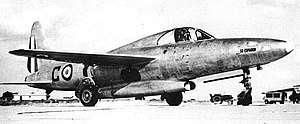Sud-Ouest Espadon
The Sud-Ouest SO.6020 Espadon (en: Swordfish) was a post-war prototype French interceptor designed and built by SNCASO. Only four aircraft were built and the type did not go into production.
| SO.6020 Espadon | |
|---|---|
 | |
| Role | Prototype interceptor |
| National origin | France |
| Manufacturer | SNCASO |
| First flight | 12 November 1948 |
| Number built | 4 |
Design and development
The single-seat interceptor was a cantilever mid-wing monoplane powered by a 5000lb thrust Rolls Royce Nene engine licence-built by Hispano-Suiza.[1] The unarmed first prototype S.O.6020.01 first flew on 12 November 1948.[1] The second prototype S.O.6020-02 had a revised fin and air inlets and was fitted with six cannon. It first flew on 30 December 1949.[1] The first prototype was later modified to the same configuration. The third prototype S.O.6020-03 was modified with an auxiliary 14.71 kN (3,307 lbf) SEPR 25 liquid-fuel rocket engine beneath the fuselage and was re-designated S.O.6025.[1]
The first prototype was modified for research use and had two wingtip-mounted Turbomeca Marbore turbojets fitted.[1] The second aircraft also had a 14.71 kN (3,307 lbf) SEPR 25 rocket engine fitted in the rear fuselage underneath the tail pipe and was re-designated as the S.O.6026.[1] The proposed production variant, the S.O.6021 first flew on 3 June 1950, it had a lighter-weight structure and a revised cockpit with an ejection seat.[1]
Variants
- S.O.6020-01
- Nene-powered prototype first flown on 12 November 1948, later fitted with two wingtip-mounted Turbomeca Marbore turbojets.[1]
- S.O.6020-02
- Second prototype first flown 30 December 1949, later modified with the addition of a 14.71 kN (3,307 lbf) SEPR 25 rocket engine and re-designated S.O.6026.[1]
- S.O.6020-03
- Third prototype, modified before first flight as the S.O.6025 also with a SEPR 25 auxiliary liquid-fuel rocket beneath the fuselage.[1]
- S.O.6021
- The proposed production aircraft based on the S.O.6020-03, but with a lighter-weight structure, ejection seat, smaller pressurised cockpit and hydraulically boosted flying controls. The sole prototype was first flown on 3 June 1950[1]
- S.O.6025
- The third prototype fitted with a SEPR 25 auxiliary liquid-fuel rocket beneath the fuselage.[1]
- S.O.6026
- The second prototype also modified with a SEPR 251 rocket engine.[1] and first flown on 4 January 1952.[2]
Surviving aircraft
The S.O.6025 in poor conservation state is at the Ailes Anciennes Toulouse museum.

Specifications (SO.6021)
Data from The Complete Book of Fighters[3]
General characteristics
- Crew: 1
- Length: 15 m (49 ft 3 in)
- Wingspan: 10.6 m (34 ft 9 in)
- Height: 4.72 m (15 ft 6 in)
- Wing area: 26.5 m2 (285 sq ft)
- Empty weight: 4,750 kg (10,472 lb)
- Gross weight: 6,870 kg (15,146 lb)
- Powerplant: 1 × Rolls-Royce Nene centrifugal compressor turbojet engine, 22 kN (5,000 lbf) thrust
Performance
- Maximum speed: 967 km/h (601 mph, 522 kn)
- Endurance: 2.5 hours
- Rate of climb: 27 m/s (5,300 ft/min)
Armament
- Guns: 6x 20 mm (0.787 in) cannon
- or 2x 30 mm (1.181 in) DEFA cannon
References
Notes
- Orbis 1985, p. 2974
- "Boosted". Flight. 4 January 1952. p. 6.
- Green, William; Gordon Swanborough (1997). The Complete Book of Fighters. London: Salamander Books Limited. ISBN 1-85833-777-1.
Bibliography
- The Illustrated Encyclopedia of Aircraft (Part Work 1982-1985). Orbis Publishing.